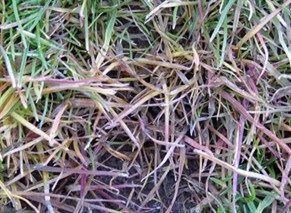When soil temperatures reach 11 to 15C at the 10 cm depth crab grass (Digitaria spp.) initiates spring germination. Crows foot grass (Eleusine indica) germinates at slightly warmer soil temperatures - between 15 and 19 C. Generally crow sfoot grass will germinate 2 to 8 weeks after crab grass. If a preemergent is to be applied, try applying just before temperatures reach this range. If you know when crab grass germinates, an old rule of thumb is to apply the pre-emergence herbicide two weeks before crab grass seed germination. Bare or thinly covered soil warms quicker than shaded dense turf.
Late Winter Brings Out the Colors in Turfgrasses
Late winter and early spring is always a strange time for turfgrasses. The weather begins to warm and both cool and warm season turfgrasses may start growing. However, temperatures are never quite warm enough, and evening temperatures may drop around freezing. The appearance and growth of the turf can appear blotchy, irregular and off color.
The most common pattern that develops on cool season turfgrasses, especially putting greens is purple patches. As discussed in previous TechNotes-SH the purpling can result from sunny relatively warm daytime temperatures (~ > 15 C) followed by a quick drop in temperature upon sunset. Sugars that have accumulated in the leaf during photosynthesis get trapped in the leaf at sunset and are unable to move to the storage regions on the plant. Some of these sugars attach to the pigments, like the purple pigments allowing for greater expression.
This purpling can also be a result of phosphorus deficiency or lack of uptake under cool soil temperatures. Some researchers, although not published are suggesting that applying foliar phosphorus during early spring when creeping bentgrass is still "purple" and the Poa annua is growing, may help green the bentgrass. That is an idea that currently has not been tested.
Additionally, when temperatures fluctuate from relatively cool to warm (> 10 C) in sunlight followed by temperatures at night close to freezing repeatedly chlorophyll degradation occurs and the plants can appear yellow.
The good news is that once warm temperatures arrive the turf will "green up".
Photograph 1: Purpling during cool temperatures can result from sugar entrapment in the leaf and sheath, or from phosphorus deficiency. Both symptoms are quite similar.

